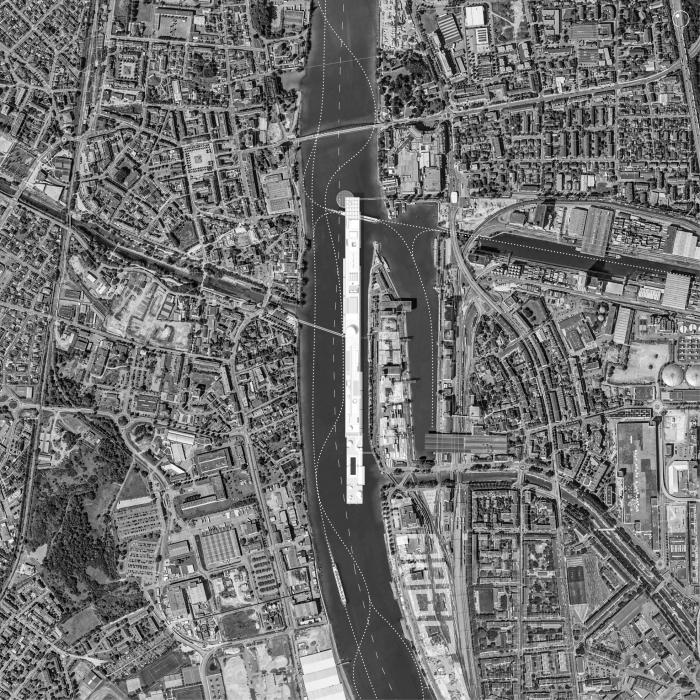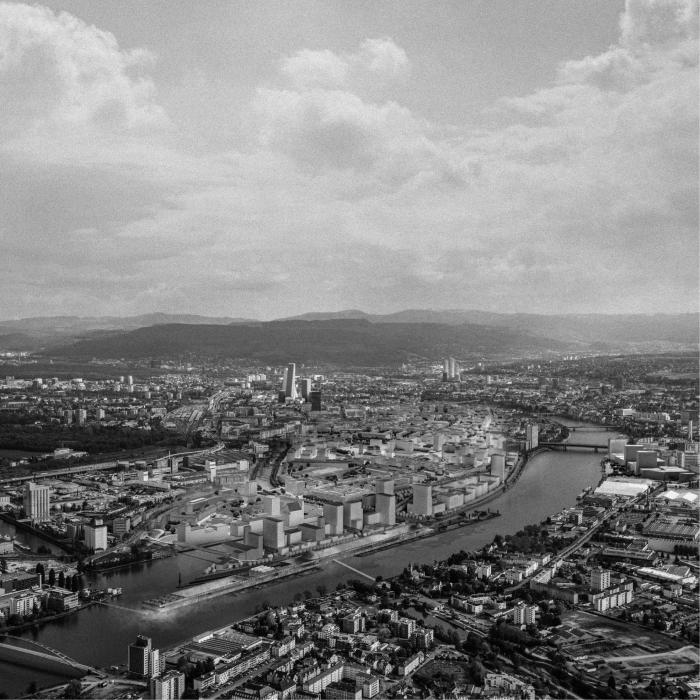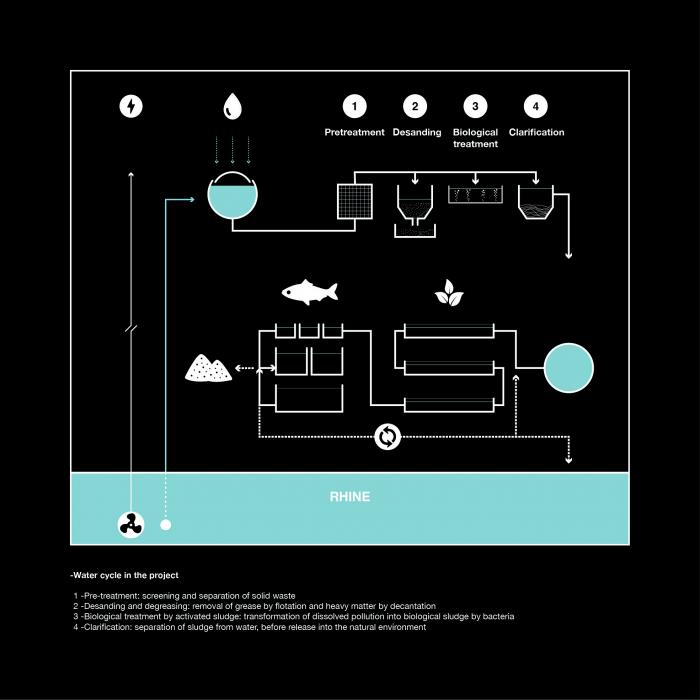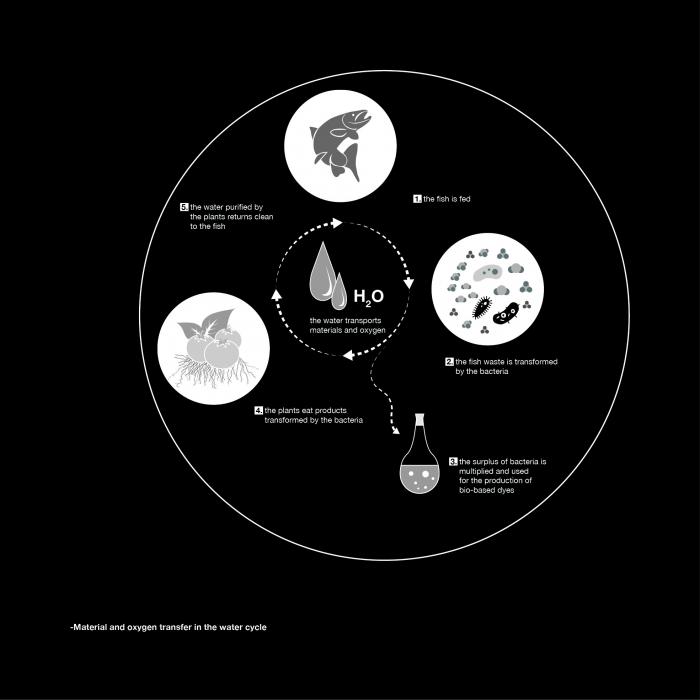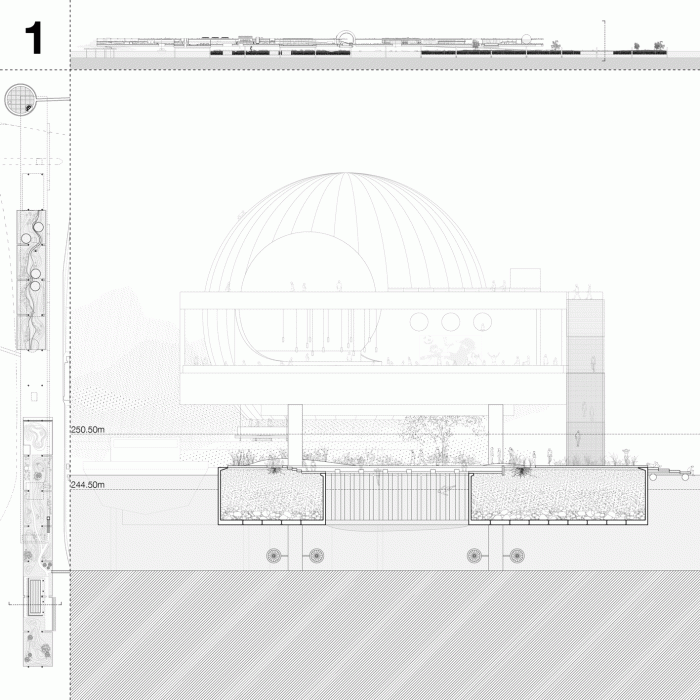Entitled (t)rhypark, this project proposes reflections on the Rhine territory and its ecological balance. The river which flows through this territory unites France, Switzerland, and Germany at one specific point: the tripoint. We believe that the landscape is no longer defined solely by administrative boundaries, but rather by the inherited context.
This is where the (t)rhypark takes place, an architecture at the service of its territory, establishing the foundations of a poetic geography.
The concept presented is based on our diploma project carried out during our studies at the Strasbourg School of Architecture.
The Rhine, with its highly symbolic character, reveals the importance of water as resource. However, despite the site in question being generously irrigated, the quality and access to the common aquatic resource remains problematic today. If it is considered such a fragile resource, this is certainly due to the dependence of the many sectors it irrigates. Indeed, water as a resource signifies the production of energy, potable water, sustenance for biodiversity, the movement of goods and people, as well as recreation. Though disturbances in its flow, temperature or quality directly affect all these sectors and threaten their very existence. It was the stigma caused by the alteration of the Rhine that determined the river as our subject of study. In 1986, the fire at the Sandoz chemical plant in Basel marks the culmination of this deterioration.
A century prior, the Rhine was considered the largest river containing salmon in Europe. However, over the past fifty years, the salmon inhabiting the Rhine has unfortunately fallen victim to the catastrophic fluvial management. As a species which exhibits certain qualities as well as being accessible, we were led to question the traditions and expertise involved in salmon pisciculture within the Rhine, and thus embarked on a contextually engaged architectural project.
In other words, this approach tackles the immaterial heritage, the intangible border between three nations with their languages and traditions, the built and natural heritage of the context, as well as the foundations of a fecund aquatic culture for Rhine. The considerable dimension of this architecture provides it the opportunity to experiment new programs and forms. It can confront itself to the scale of the landscape surrounding it, and hence ensure territorial cohesion, as well as re-enchanting the natural heritage of the Rhine.
Please highlight how the concept/idea can be exemplary in this context
The project takes the form of a floating structure, placed upon the Rhine in the direction of its flow, on the border between the three countries. Various programs are deployed, in the form of micro-systems dedicated to the protection of the natural heritage, the production of raw materials and finally leisure activities. These consist mainly of accompanying the various stages of maturation of the salmon in fresh water, prior to its migration to salt water. The objective is to participate in the reintroduction of salmon into the Rhine and to allow the river to gradually recover its salmonic character.
This first part of the program is accompanied by aquaculture production, taking advantage of the rich nutrients released by the fish, while ensuring natural water purification. This reinterpreted culture allows for continuous plant production without chemical inputs and with 90% less water consumption than soil-based cultures. The production of bio-based pigments completes this productive ensemble, echoing past industrial neglect that has greatly polluted the water system on a large scale. Reconstituting this knowledge and adapting it to current issues shows that it is possible to renew oneself from one decade to the next, and to reinvent oneself from one century to the next without disregard for the past.
In terms of production, the aim is to create as many links as possible between the different entities of the program. The objective being the convergence of activities that were not initially associated. Their common denominator is the indispensable use of water for their proper functioning: irrigation, rinsing, heating, treatment, cooling (etc.). The fact that the different stages of aquaculture and green chemistry processes were combined enabled us to create a high-performance system, allowing each part of the program to feed the other and reduce losses.
Please highlight how the concept/idea can be exemplary in this context
The infrastructural dimension proposed by our diploma project was primarily a way of stimulating the utopic aspect, all the while crossing issues at the scale of the territory, the city, and the ecosystems. At the same time a good place and a non-place, the utopia seemed to be an effective tool for embodying the foundations of our reflection.
As a result, this experimental platform is intended to be attentive to the evolution of the flow rate, the quality, the temperature, and consequently to the different changes of state of water. Be it condensation, evaporation or solidification, these variations help to awaken the user's senses and question our way of understanding, protecting, and appreciating this common good. This notion of sharing is, in our opinion, essential for a productive culture of the Rhine. This playful experience joins the various programs mentioned above and contributes to the design of this open-air "laboratory".
Composed of a floating level, a built thickness and a roof terrace open to the city, the architecture reveals, materializes, and allows us to inhabit the border, by strategically implanting itself on the Rhine, to reveal, mask or enhance the architectural and urban heritage present on the banks. To those who see in the project a boat, we counter that it is architecture. To those who seek architecture, we will speak of boats. Nevertheless, this new public space, which does not belong to any of the three countries, reflects the scale of the context, facilitates the crossing of the river and tries to reinforce the feeling of belonging for the inhabitants.
Please highlight how the concept/idea can be exemplary in this context
While the focus so far has been on the protection and enhancement of the natural heritage and the skills which this entails, the final part of the program focuses on leisure activities and offers different forms of access to the water for visitors.
However, recreation is not limited to the pleasures of the water. Catering areas, a floating park and spaces without function, which can be freely appropriated, particularly on the roof, complete the ensemble. These places accumulate a very large number of functions and activities, synonymous with intensity and attractiveness. A place where one can have a coffee, park one's bike, recharge one's battery, pick up a parcel, leave one's luggage, look at the exhibitions of the surrounding museums, chat, draw, listen to music, play, dance or even watch a film. These in-between spaces, which would normally be dedicated to waiting or passing, encourage encounters and exchanges with others, adding value to the Franco-German-Swiss border.
But what is a border really? If a border between countries is usually no more and no less than an administrative limit, it is above all materialized by its thickness. This physical boundary intersects with territorial dynamics and allows local cultures to build on regional potentials. In our case, the border between the three countries is not limited to the thickness of the Rhine but leads us to consider the entirety of the area in which the river is situated.
Thus, this nuance leads us to reconsider our usage of the border. Going beyond traversing a limit, this project invites the user to walk along it, to embrace it, and seeks to make the experience unique: a fundamentally human place where everyone cohabits.
Please highlight how this approach can be exemplary
The foundations of the concept are largely based on the notions of sustainability and circularity. The quality and use of the water resource is the starting point of our thinking, and this is the basis for the choice of programs and their relationship: a water machine, capable of filtering the Rhine. This programmatic synergy is made possible by man, but it is above all imagined for him. Indeed, the natural cycle of water, its accessibility, as well as its use, condition the habitability of the territory. Production, protection, and leisure are intertwined. The effervescence that emerges from these interactions is the desired result of a resilient micro-system, integrated into the local ecosystem.
The metaphor of the boat transports us and gives us a glimpse of an experience, born above all out of a fascination for these scientific and technical disciplines linked to architecture. The understanding of the territory fully justifies these choices. This Noah's Ark is open to the greatest number of people and strives to offer a natural, landscaped, and architecturally sound setting with which users can easily identify. This feeling of belonging is even more important in the context of the Upper Rhine, where the river marks the border between Germany, France, and Switzerland. Thus, in addition to the large-scale environmental issues, this project is nothing other than a public space on the Rhine, crystallizing the environmental, social, and cultural dynamics common to these cross-border territories.
The utopian image that accompanies the project invites us today to imagine more concretely how to materialize this concept. Both on the urban and landscape scale, as well as on the architectural scale, we are convinced of the importance of an architecture that is mindful of its context, relying on the use of simple, tested materials, capable of withstanding the test of time.
Today, more than ever, we are convinced of the role that the architect plays in the transitions of our territories and living environments. These urgent adaptations push us, as young architects, to take advantage of the experiments and theoretical contributions resulting from this diploma project, to reinject them into our future practice. Beyond the territorial dynamics in which this project is inscribed, the background story of this university work invites us to innovate in the fields that it crosses on a scientific, cultural and social level.
Mindful of the context and territorial complexity in which it is embedded, this project seeks to acknowledge the local cultures and places from which it draws its inspiration. Indeed, its generosity towards the territory and its inhabitants is manifested in the programs implemented and the constructive choices made, offering a new architectural, cultural and social experience.
The general concept attempts to provide an original response to the thorny issue of water management, drawing on the natural and elemental riches of the territory and the site. Ultimately, the aim would be to initiate discussions to imagine what alternative and complementary management of the resource looks like. Thus, it justifies its form and location by the fact that it envisages a new relationship with water, natural heritage, with the designs of our borders and with the cultures that are implanted in them, intangible heritage, and with the context, material heritage, which is indispensable to this productive culture of the Rhine.
But let us now look at the directions envisaged for the implementation of this alternative place capable of evolving and adapting according to needs. What form should be adopted to concretely materialize the project? What stages should be considered in the design process?
The announced ambitions of frugality would not be complete if this concept couldn’t be developed concretely. In fact, the dynamics instilled by the initiative of the new European Bauhaus, lead us today to deepen the theoretical contributions of this university project, by drawing with the inhabitants of the territory, the specialists and the people involved, an adapted and feasible architectural response.
The scale of the project is deliberately not specified, but simply suggested. For us, it is a question of an architecture that can be easily adapted, that can respond locally to the Rhine context, but that can also be adapted more generally according to needs. This spatial experience is naturally based on economy of means, speed of implementation, modularity, and flexibility. These intrinsic qualities of lightweight construction are in line with a participative design and construction where aesthetics reveal benevolence towards the territory and its inhabitants.
The constructive freedom towards which we wish to strive reinforces the inclusive dimension of the project. Indeed, its design is not fixed. On the contrary, this open proposal is for the time being a simple sketch, a basis for discussion for its further development. These exchanges are essential to ensure the project's capacity to adapt to current social, technical, economic, and environmental expectations, as we are all at the origin of the transition of our territories and our living environments.
We are aware that this work is not done alone but is part of the steps already taken in the territory in order to formally translate the concept and make it a reality. An award for the "New European Bauhaus 2022" prize would therefore allow us not only to share the theoretical work carried out, but also to continue this pedagogical experience by meeting the people who are already working in the fields in question in the territory.
Among them, we have the current students at the Ecole Nationale Supérieure d'Architecture de Strasbourg in mind, as well as at the students of the Ecole Nationale du Génie de l'Eau et de l'Environnement de Strasbourg, who have been jointly rewarded in 2021 for their collaborative project entitled "Ville, Eau, Paysage" (City, Water, Landscape) by the Agence de l'eau Rhin-Meuse. We share the objective of crossing the views of architects, scientists, and hydraulic engineers in order to defend the hydrological, ecological and social issues present in the territory.
Having the opportunity to meet them during the university year and intervening within the different actors concerned (elected officials, students, citizens, etc.) would, in our opinion, make it possible to establish a dialogue, to raise awareness, to nourish everyone's imagination as well as to experiment at different scales with the hypotheses and theoretical foundations presented here.
@Higelin, 2022
Content licensed to the European Union.
